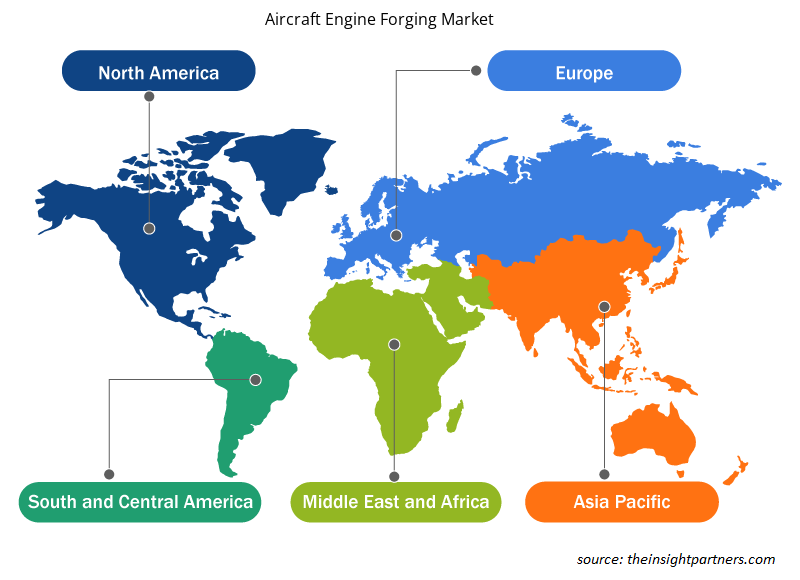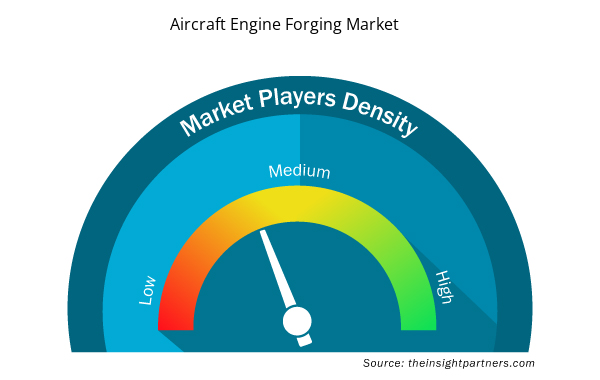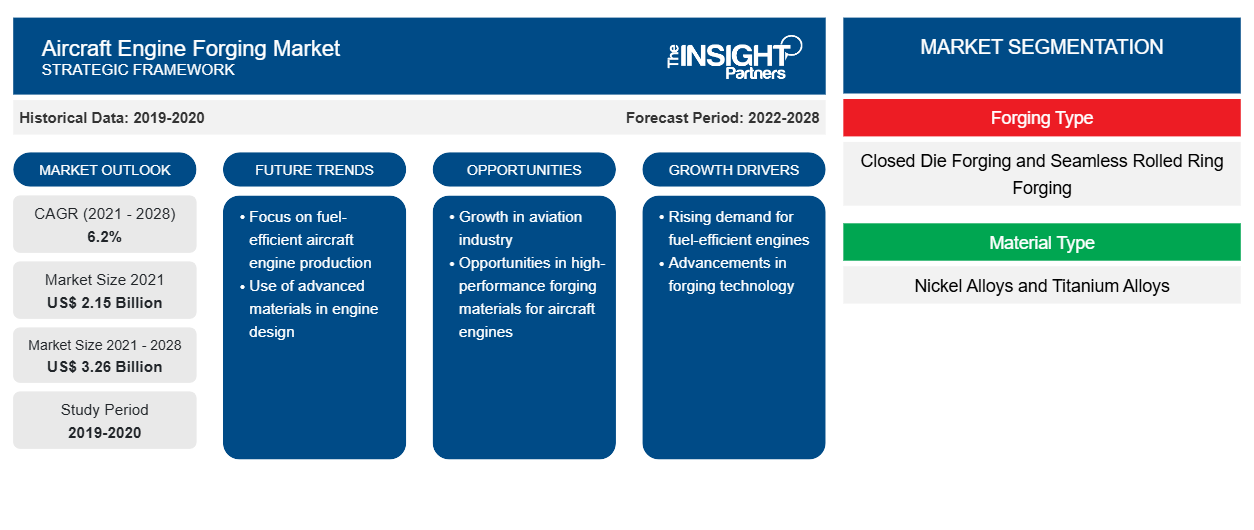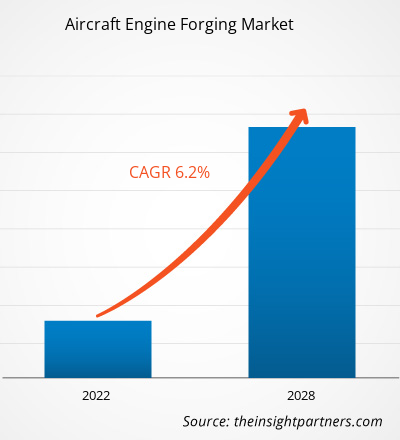Si prevede che il mercato della forgiatura di motori aeronautici raggiungerà i 3.260,77 milioni di dollari entro il 2028, rispetto ai 2.145,80 milioni di dollari del 2021; si prevede una crescita a un CAGR del 6,2% dal 2021 al 2028.
Secondo l'International Air Transport Association, si prevede che i passeggeri aerei quadruplicheranno nei prossimi due decenni. Si prevede che circa 8,2 miliardi di passeggeri avranno viaggiato in aereo entro il 2037. Con l'aumento del traffico passeggeri, i principali produttori di aeromobili come Airbus e Boeing prevedono un aumento delle consegne dei loro aeromobili commerciali nei prossimi anni. Pertanto, un aumento del traffico passeggeri aereo in vari paesi è un fattore chiave che guida il mercato della forgiatura dei motori aeronautici . Inoltre, la capacità di produzione di aeromobili continua ad aumentare in risposta all'aumento del traffico aereo e all'introduzione di aeromobili di nuova generazione. L'aumento della produzione di aeromobili stimolerebbe ulteriormente le attività di forgiatura dei motori aeronautici. Il processo di forgiatura dei componenti dei motori aeronautici include tecniche di lavorazione dei metalli e lavorazioni meccaniche come la forgiatura a matrice chiusa, la forgiatura a matrice senza saldatura e la forgiatura isotermica.
Personalizza questo report in base alle tue esigenze
Riceverai la personalizzazione gratuita di qualsiasi report, comprese parti di questo report, o analisi a livello nazionale, pacchetto dati Excel, oltre a usufruire di grandi offerte e sconti per start-up e università
- Scopri le principali tendenze di mercato in questo rapporto.Questo campione GRATUITO includerà analisi di dati che spaziano dalle tendenze di mercato alle stime e alle previsioni.
Impatto della pandemia di COVID-19 sul mercato della forgiatura dei motori aeronautici
Gli Stati Uniti hanno assistito all'impatto più grave del COVID-19 nel 2020 e nel 2021. I produttori di motori aeronautici e i produttori di componenti per motori nel paese sono stati colpiti a causa di blocchi nazionali e restrizioni di viaggio, chiusura di stabilimenti di produzione e carenza di dipendenti. La massiccia epidemia del virus ha creato sia una crisi sanitaria che una crisi economica negli Stati Uniti. Ha portato a gravi interruzioni nel settore aerospaziale, con un impatto su tutto, dalla catena di fornitura e produzione alle vendite di prodotti. La pandemia ha avuto un impatto diretto e indiretto sulle strategie a breve e lungo termine del settore.
Approfondimenti di mercato – Mercato della forgiatura dei motori aeronautici
Il Nord America ha registrato un aumento della domanda di motori per aeromobili dovuto alla rapida e precoce adozione di motori per aeromobili tecnologicamente avanzati. Il fiorente settore aerospaziale e dell'aviazione da difesa nella regione incoraggia i produttori di motori per aeromobili a fornire prodotti tecnologicamente innovativi ed efficienti per vari tipi di aeromobili. È probabile che l'industria dei motori per aeromobili nel Nord America sia guidata dalla crescente domanda di questi motori e dalla presenza di diversi importanti concorrenti, tra cui General Electric Company, Honeywell International Inc., Collins Aerospace e Pratt & Whitney. Queste aziende intraprendono vigorose attività di R&S per espandere le loro linee di prodotti e produrre motori per aeromobili con sistemi, sottosistemi e altri componenti tecnologicamente migliorati. Pertanto, la crescita dell'industria dei motori per aeromobili sta supportando la crescita del mercato della forgiatura dei motori per aeromobili in tutto il Nord America.
Informazioni basate sul tipo di materiale
In base al tipo di materiale, la quota di mercato della forgiatura di motori aeronautici è segmentata in lega di titanio e lega di nichel. La lega di nichel ha rappresentato la quota maggiore nel 2020. Numerose aziende di forgiatura che operano nel settore aerospaziale (indipendentemente dal motore o dalle parti strutturali) sono più inclini all'uso di superleghe di nichel. Questi materiali hanno proprietà di resistenza alle alte temperature e al calore. Le leghe di nichel sono utilizzate nelle turbine a gas per l'energia edilizia, pale, rotori, turbo e motori aeronautici a turbina, turbine a vapore, ugelli di propulsione, apparecchiature di processo, valvole, pompe e altre parti che devono resistere in ambienti critici. Le leghe di nichel sono ideali per gli ambienti in cui la temperatura è vicina ai 1000 gradi F. Da qui in poi, in un motore aeronautico, le leghe di nichel sono utilizzate nella camera di combustione e nella turbina. Per quanto riguarda la temperatura è elevata nella metà posteriore, in un motore aeronautico viene utilizzata una lega a base di ferro o nichel. La domanda di lega di nichel è estremamente elevata sia nelle tecniche di forgiatura a matrice chiusa che aperta. Ad esempio, Aubert & Duval ha recentemente sviluppato AD730. Si tratta di una nuova superlega a base di nichel che resiste a temperature più elevate di 1.350 °F mantenendo forza, resistenza alla fatica e creep a un costo competitivo.
Il mercato della forgiatura dei motori aeronautici è segmentato in base al tipo di forgiatura, al tipo di materiale, all'utente finale e alla geografia. In base al tipo, il mercato della forgiatura dei motori aeronautici è suddiviso in forgiatura a matrice chiusa e forgiatura ad anello laminato senza saldatura. In base al tipo di materiale, il mercato è suddiviso in leghe di nichel e leghe di titanio. In base all'utente finale, il mercato è ulteriormente suddiviso in cassa della ventola, cassa esterna della camera di combustione, disco della turbina, rotori e altri. In base alla geografia, le dimensioni del mercato della forgiatura dei motori aeronautici sono principalmente segmentate in Nord America, Europa, Asia Pacifico (APAC), Medio Oriente e Africa (MEA) e Sud e Centro America. All Metals & Forge Group, ATI Metals, Doncasters Group Ltd, Farinia Group, Lisi Aerospace, Otto Fuchs GmbH, Pacific Forge Incorporated e Precision Castparts Corp. sono tra i principali attori profilati durante lo studio del mercato della forgiatura dei motori aeronautici.
Approfondimenti regionali sul mercato della forgiatura dei motori aeronautici
Le tendenze regionali e i fattori che influenzano il mercato della forgiatura dei motori aeronautici durante il periodo di previsione sono stati ampiamente spiegati dagli analisti di Insight Partners. Questa sezione discute anche i segmenti e la geografia del mercato della forgiatura dei motori aeronautici in Nord America, Europa, Asia Pacifico, Medio Oriente e Africa e America meridionale e centrale.

- Ottieni i dati specifici regionali per il mercato della forgiatura dei motori degli aeromobili
Ambito del rapporto di mercato sulla forgiatura dei motori degli aeromobili
| Attributo del report | Dettagli |
|---|---|
| Dimensioni del mercato nel 2021 | 2,15 miliardi di dollari USA |
| Dimensioni del mercato entro il 2028 | 3,26 miliardi di dollari USA |
| CAGR globale (2021 - 2028) | 6,2% |
| Dati storici | 2019-2020 |
| Periodo di previsione | 2022-2028 |
| Segmenti coperti | Per tipo di forgiatura
|
| Regioni e Paesi coperti | America del Nord
|
| Leader di mercato e profili aziendali chiave |
|
Densità degli attori del mercato: comprendere il suo impatto sulle dinamiche aziendali
Il mercato della forgiatura dei motori aeronautici sta crescendo rapidamente, spinto dalla crescente domanda degli utenti finali dovuta a fattori quali l'evoluzione delle preferenze dei consumatori, i progressi tecnologici e una maggiore consapevolezza dei vantaggi del prodotto. Con l'aumento della domanda, le aziende stanno ampliando le loro offerte, innovando per soddisfare le esigenze dei consumatori e capitalizzando sulle tendenze emergenti, il che alimenta ulteriormente la crescita del mercato.
La densità degli operatori di mercato si riferisce alla distribuzione di aziende o società che operano in un particolare mercato o settore. Indica quanti concorrenti (operatori di mercato) sono presenti in un dato spazio di mercato in relazione alle sue dimensioni o al valore di mercato totale.
Le principali aziende che operano nel mercato della forgiatura dei motori aeronautici sono:
- Tutti i metalli e il gruppo Forge
- ATI
- Gruppo Doncaster Ltd
- Gruppo Farinia
- Lisi Aerospaziale
Disclaimer : le aziende elencate sopra non sono classificate secondo un ordine particolare.

- Ottieni una panoramica dei principali attori del mercato della forgiatura dei motori aeronautici
Gli operatori che operano nel mercato della forgiatura dei motori aeronautici si concentrano principalmente sullo sviluppo di prodotti avanzati ed efficienti.
- Nel 2019, Doncasters ha venduto le sue due attività con attività a Sheffield, Shrewsbury e Blaenavon. Blaenavon Forgings è stata venduta a una società di private equity statunitense, Arlington Capital Partners, e la sua attività UK Fabrications a Radius Aerospace.
- Nel 2018, LISI Aerospace ha sviluppato la tecnologia di forgiatura "hot dies" presso il suo stabilimento Forges de Bologne. Questo nuovo concetto aiuta a mantenere la produttività della forgiatura convenzionale, ottenendo al contempo una qualità metallurgica vicina a quella delle forgiature isotermiche, ovvero un impianto di forgiatura che opera a 1.250/1.300 °C, in termini di omogeneità della microstruttura e salute esterna delle parti.
- Analisi storica (2 anni), anno base, previsione (7 anni) con CAGR
- Analisi PEST e SWOT
- Valore/volume delle dimensioni del mercato - Globale, regionale, nazionale
- Industria e panorama competitivo
- Set di dati Excel



Report Coverage
Revenue forecast, Company Analysis, Industry landscape, Growth factors, and Trends

Segment Covered
This text is related
to segments covered.

Regional Scope
North America, Europe, Asia Pacific, Middle East & Africa, South & Central America

Country Scope
This text is related
to country scope.
Domande frequenti
The global aviation industry is experiencing huge demand for air travel, for both military and commercial purposes. This is leading the aircraft manufacturers to procure the latest aircraft models, and models and adopt new and robust technologies. Therefore, the production of the next generation of aircraft is expected to be one of the key trends in the aviation industry in the future. The trend is predicted to pitch over the period, leading to huge opportunities for the proliferation of aircraft component forging players
China dominated the APAC aircraft engine forging market in 2020. With a rising population in China, the adoption of air transportation is also growing. The plan of China related to the procurement of new helicopters is increased by 9%, which provides more opportunities to the engine forging companies. The aviation industry is among the top ten key areas of focus in the “Made in China 2025†initiative. To achieve this pre-determined goal, the country is heavily dependent on imported engines, avionics, and other critical components/parts. These ‘one-generation-behind’ new aircraft are projected to assist in the growth of China.
ATI Metals, Safran, Precision Castparts Corp., Arconic, and Otto Fuchs are the five key market players operating in the global aircraft engine forging market. We have derived this listing of “Key Five Players†in the global aircraft engine forging market by giving weightage to the following key parameters: overall revenue, segmental revenue, brand image & industry experience, current geotechnical construction services portfolio, customer base, geographical reach, partnerships, mergers & acquisitions, and other market-related activities.
The aircraft engine forging market is dominated by closed die forging segment which held a market share of 62.5% in 2020 and is anticipated to continue its dominance during the forecast period to account for 58.4% of the aircraft engine forging market share by 2028.
The rise in the manufacturing of aircraft is directly magnifying the demand for aircraft engines over years. Additionally, airlines, aircraft operators, armed forces, and charter operators are likely to boost the demand for new engines as part of their fleet modernization and growth plans. The growing need for a new generation of engines with low emissions and weight, which would improve airplane fuel efficiency, is also contributing to the aircraft engine forging market proliferation.
North America held the largest share of the global aircraft engine forging market. North America has experienced a rise in demand for aircraft engines due to the early and rapid adoption of technologically advanced airplane engines. The booming aerospace and defense aviation business in the region encourages aircraft engine manufacturers to provide technologically innovative and efficient products for various aircraft types. The aircraft engine industry in North America is likely to be driven by rising demand for these engines and the presence of several major competitors, including General Electric Company, Honeywell International Inc., Collins Aerospace, and Pratt & Whitney. These companies undertake vigorous R&D activities to expand their product lines and manufacture aircraft engines with technologically improved systems, subsystems, and other components. Thus, the growth of the aircraft engine industry is supporting the growth of the aircraft engine forging market across North America.
Trends and growth analysis reports related to Aerospace and Defense : READ MORE..
The List of Companies - Aircraft Engine Forging Market
- All Metals and Forge Group
- ATI
- Doncaster Group Ltd
- Farinia Group
- Lisi Aerospace
- Otto Fuchs GmbH
- Pacific Forge Incorporated
- Precision Castparts Corp.
- Safran
- VSMPO-AVISMA Corporation
The Insight Partners performs research in 4 major stages: Data Collection & Secondary Research, Primary Research, Data Analysis and Data Triangulation & Final Review.
- Data Collection and Secondary Research:
As a market research and consulting firm operating from a decade, we have published and advised several client across the globe. First step for any study will start with an assessment of currently available data and insights from existing reports. Further, historical and current market information is collected from Investor Presentations, Annual Reports, SEC Filings, etc., and other information related to company’s performance and market positioning are gathered from Paid Databases (Factiva, Hoovers, and Reuters) and various other publications available in public domain.
Several associations trade associates, technical forums, institutes, societies and organization are accessed to gain technical as well as market related insights through their publications such as research papers, blogs and press releases related to the studies are referred to get cues about the market. Further, white papers, journals, magazines, and other news articles published in last 3 years are scrutinized and analyzed to understand the current market trends.
- Primary Research:
The primarily interview analysis comprise of data obtained from industry participants interview and answers to survey questions gathered by in-house primary team.
For primary research, interviews are conducted with industry experts/CEOs/Marketing Managers/VPs/Subject Matter Experts from both demand and supply side to get a 360-degree view of the market. The primary team conducts several interviews based on the complexity of the markets to understand the various market trends and dynamics which makes research more credible and precise.
A typical research interview fulfils the following functions:
- Provides first-hand information on the market size, market trends, growth trends, competitive landscape, and outlook
- Validates and strengthens in-house secondary research findings
- Develops the analysis team’s expertise and market understanding
Primary research involves email interactions and telephone interviews for each market, category, segment, and sub-segment across geographies. The participants who typically take part in such a process include, but are not limited to:
- Industry participants: VPs, business development managers, market intelligence managers and national sales managers
- Outside experts: Valuation experts, research analysts and key opinion leaders specializing in the electronics and semiconductor industry.
Below is the breakup of our primary respondents by company, designation, and region:

Once we receive the confirmation from primary research sources or primary respondents, we finalize the base year market estimation and forecast the data as per the macroeconomic and microeconomic factors assessed during data collection.
- Data Analysis:
Once data is validated through both secondary as well as primary respondents, we finalize the market estimations by hypothesis formulation and factor analysis at regional and country level.
- Macro-Economic Factor Analysis:
We analyse macroeconomic indicators such the gross domestic product (GDP), increase in the demand for goods and services across industries, technological advancement, regional economic growth, governmental policies, the influence of COVID-19, PEST analysis, and other aspects. This analysis aids in setting benchmarks for various nations/regions and approximating market splits. Additionally, the general trend of the aforementioned components aid in determining the market's development possibilities.
- Country Level Data:
Various factors that are especially aligned to the country are taken into account to determine the market size for a certain area and country, including the presence of vendors, such as headquarters and offices, the country's GDP, demand patterns, and industry growth. To comprehend the market dynamics for the nation, a number of growth variables, inhibitors, application areas, and current market trends are researched. The aforementioned elements aid in determining the country's overall market's growth potential.
- Company Profile:
The “Table of Contents” is formulated by listing and analyzing more than 25 - 30 companies operating in the market ecosystem across geographies. However, we profile only 10 companies as a standard practice in our syndicate reports. These 10 companies comprise leading, emerging, and regional players. Nonetheless, our analysis is not restricted to the 10 listed companies, we also analyze other companies present in the market to develop a holistic view and understand the prevailing trends. The “Company Profiles” section in the report covers key facts, business description, products & services, financial information, SWOT analysis, and key developments. The financial information presented is extracted from the annual reports and official documents of the publicly listed companies. Upon collecting the information for the sections of respective companies, we verify them via various primary sources and then compile the data in respective company profiles. The company level information helps us in deriving the base number as well as in forecasting the market size.
- Developing Base Number:
Aggregation of sales statistics (2020-2022) and macro-economic factor, and other secondary and primary research insights are utilized to arrive at base number and related market shares for 2022. The data gaps are identified in this step and relevant market data is analyzed, collected from paid primary interviews or databases. On finalizing the base year market size, forecasts are developed on the basis of macro-economic, industry and market growth factors and company level analysis.
- Data Triangulation and Final Review:
The market findings and base year market size calculations are validated from supply as well as demand side. Demand side validations are based on macro-economic factor analysis and benchmarks for respective regions and countries. In case of supply side validations, revenues of major companies are estimated (in case not available) based on industry benchmark, approximate number of employees, product portfolio, and primary interviews revenues are gathered. Further revenue from target product/service segment is assessed to avoid overshooting of market statistics. In case of heavy deviations between supply and demand side values, all thes steps are repeated to achieve synchronization.
We follow an iterative model, wherein we share our research findings with Subject Matter Experts (SME’s) and Key Opinion Leaders (KOLs) until consensus view of the market is not formulated – this model negates any drastic deviation in the opinions of experts. Only validated and universally acceptable research findings are quoted in our reports.
We have important check points that we use to validate our research findings – which we call – data triangulation, where we validate the information, we generate from secondary sources with primary interviews and then we re-validate with our internal data bases and Subject matter experts. This comprehensive model enables us to deliver high quality, reliable data in shortest possible time.


 Ottieni un campione gratuito per questo repot
Ottieni un campione gratuito per questo repot